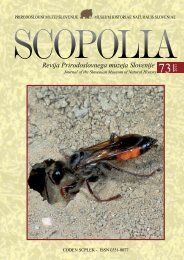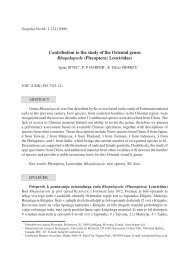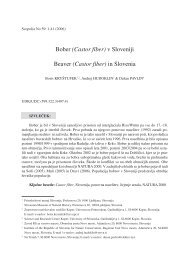Two new records of Heteroptera species in Slovenia - Kmetijsko ...
Two new records of Heteroptera species in Slovenia - Kmetijsko ...
Two new records of Heteroptera species in Slovenia - Kmetijsko ...
Create successful ePaper yourself
Turn your PDF publications into a flip-book with our unique Google optimized e-Paper software.
ACTA ENTOMOLOGICA SLOVENICA<br />
LJUBLJANA, JUNIJ 2010 Vol. 18, øt. 1: 63-70<br />
FAVNISTIŒNI ZAPISKI / FAUNISTICAL NOTES<br />
TWO NEW RECORDS OF HETEROPTERA SPECIES IN SLOVENIA<br />
Andrej GOGALA 1 & Gabrijel SELJAK 2<br />
1<br />
Prirodoslovni muzej Slovenije, Preøernova 20, p.p. 290, SI-1001 Ljubljana,<br />
e-mail: agogala@pms-lj.si<br />
2<br />
<strong>Kmetijsko</strong> gozdarski zavod Nova Gorica, Pri hrastu 18, 5000 Nova Gorica,<br />
<strong>Slovenia</strong><br />
Abstract - Stephanitis pyrioides (Scott, 1874), an <strong>in</strong>troduced <strong>species</strong>, and<br />
Deraeocoris schach (Fabricius, 1781) are two <strong>species</strong> <strong>of</strong> <strong>Heteroptera</strong>, found <strong>in</strong><br />
<strong>Slovenia</strong> for the first time <strong>in</strong> 2009. The data on the f<strong>in</strong>ds are presented.<br />
KEY WORDS: Hemiptera, T<strong>in</strong>gidae, Miridae, fauna, <strong>Slovenia</strong>.<br />
Izvleœek – DVE NOVI NAJDBI VRST REDA HETEROPTERA V SLOVENIJI<br />
Stephanitis pyrioides (Scott, 1874), zaneøena vrsta, <strong>in</strong> Deraeocoris schach<br />
(Fabricius, 1781) sta dve vrsti stenic, v Sloveniji prviœ najdeni v letu 2009.<br />
Predstavljeni so podatki o najdbah.<br />
KLJUŒNE BESEDE: Hemiptera, T<strong>in</strong>gidae, Miridae, favna, Slovenija.<br />
The number <strong>of</strong> <strong>Heteroptera</strong> <strong>species</strong> recorded <strong>in</strong> <strong>Slovenia</strong> rose to 738 when two<br />
additional <strong>species</strong> were found <strong>in</strong> 2009. One <strong>of</strong> them is a member <strong>of</strong> the<br />
Mediterranean fauna and was found <strong>in</strong> the most xerotherm locality <strong>in</strong> the country.<br />
The other is an <strong>in</strong>troduced <strong>species</strong>, a pest <strong>of</strong> cultivated plants. It is the second <strong>new</strong><br />
lace bug <strong>species</strong> recorded <strong>in</strong> 2009, after discovery <strong>of</strong> the native Hyalochiton<br />
komar<strong>of</strong>fii (Kunz & Frieß 2009).<br />
List <strong>of</strong> <strong>species</strong><br />
TINGIDAE<br />
Stephanitis pyrioides (Scott, 1874)<br />
Nova Gorica, UL98, 90 m, 22. 10. 2009 on Rhododendron japonicum, G. Seljak leg.<br />
63
Acta entomologica slovenica, 18 (1), 2010<br />
1 2<br />
3 4<br />
Fig. 1: Stephanitis pyrioides, adult.<br />
Fig. 2: Stephanitis pyrioides, a nymph on the underside <strong>of</strong> a leaf.<br />
Fig. 3: Severe <strong>in</strong>juries on leaves <strong>of</strong> Japanese azalea. Figs. 1-3 Photo G. Seljak.<br />
Fig. 4: Deraeocoris schach, female on a Malva sp. plant. Photo A. Gogala.<br />
Orig<strong>in</strong>at<strong>in</strong>g from Ch<strong>in</strong>a, Japan, Korea, Taiwan and Russian Far East (Péricart &<br />
Golub 1996), this lace bug <strong>species</strong> is transported around the world with ornamental<br />
plants. Its food plants are cultivated <strong>species</strong> <strong>of</strong> Rhododendron (particularly Azalea),<br />
which are damaged by the bugs suck<strong>in</strong>g leaf cells (Figs. 1-3). It was recorded <strong>in</strong><br />
Europe (the Netherlands) already <strong>in</strong> 1905, but populations did not persist for long<br />
(Péricart 1983). In 1995 and 1998 <strong>new</strong> <strong>in</strong>troductions to the Netherlands were recorded,<br />
as well as to Greece, Italy, France and Switzerland <strong>in</strong> recent years (Rabitsch<br />
2008). In the DAISIE database it is recorded also for Albania.<br />
The so-called Azalea lace bug overw<strong>in</strong>ters <strong>in</strong> the egg stage. It develops 3-5 generations<br />
each year (Buss and Turner 2006). The first occurrence <strong>of</strong> S. pyrioides <strong>in</strong> Nova<br />
64
Gogala A., Seljak G., <strong>Two</strong> <strong>new</strong> <strong>records</strong> <strong>of</strong> <strong>Heteroptera</strong> <strong>species</strong> <strong>in</strong> <strong>Slovenia</strong><br />
Gorica was discovered quite late <strong>in</strong> the season. Only larvae and nymphs were found<br />
on heavy damaged azalea shrubs, but they could be easily reared to adults <strong>in</strong> lab conditions.<br />
The orig<strong>in</strong> <strong>of</strong> this <strong>in</strong>festation rema<strong>in</strong>s unknown.<br />
MIRIDAE<br />
Deraeocoris schach (Fabricius, 1781)<br />
Osp, VL14, 13. 6. 2009, 1 female on Malva, A. Gogala leg.<br />
A Mediterranean and predatory <strong>species</strong>. It is frequent <strong>in</strong> Dalmatia. The <strong>Slovenia</strong>n<br />
locality is situated at the Karst edge, on a xerotherm slope protected from the bora<br />
w<strong>in</strong>d by rock escarpment. The specimen was found on Malva sp. (Fig. 4) together<br />
with other <strong>Heteroptera</strong> <strong>species</strong>. The largest fragment <strong>of</strong> the Mediterranean macchia<br />
<strong>in</strong> <strong>Slovenia</strong> is situated <strong>in</strong> the rock escarpment above the f<strong>in</strong>d<strong>in</strong>g place.<br />
Discussion<br />
The number <strong>of</strong> <strong>in</strong>troduced <strong>species</strong> is ris<strong>in</strong>g <strong>in</strong> Europe and other parts <strong>of</strong> the world,<br />
ma<strong>in</strong>ly as a consequence <strong>of</strong> globalized trade. A factor contribut<strong>in</strong>g to this is probably<br />
also global warm<strong>in</strong>g which is enabl<strong>in</strong>g the spread <strong>of</strong> many Mediterranean <strong>species</strong><br />
to the north. <strong>Slovenia</strong> is not excluded from this trend, so <strong>new</strong> f<strong>in</strong>ds may be expected<br />
<strong>in</strong> the future. Many native <strong>species</strong>, however, have become scarce and are disappear<strong>in</strong>g.<br />
References<br />
Buss, A. E., J. C. Turner, 2006: Lace Bugs on Ornamental Plants. ENY-332,<br />
University <strong>of</strong> Florida: 1-4.<br />
Kunz, G., T. Frieß, 2009: First record <strong>of</strong> Hyalochiton komar<strong>of</strong>fii <strong>in</strong> <strong>Slovenia</strong><br />
(<strong>Heteroptera</strong>: T<strong>in</strong>gidae). Acta entomologica slovenica, 17 (1): 83-86.<br />
Péricart, J., 1983: Hémiptères T<strong>in</strong>gidae Euro-Méditerranéens. Faune de France, 69.<br />
Péricart, J., V. B. Golub, 1996: Superfamily T<strong>in</strong>goidea. In: Aukema & Rieger:<br />
Catalogue <strong>of</strong> the <strong>Heteroptera</strong> <strong>of</strong> the Palaearctic Region, Volume 2:<br />
Cimicomorpha I, pp. 3-78. Amsterdam.<br />
Rabitsch, W., 2008: Alien true bugs <strong>of</strong> Europe (Insecta: Hemiptera: <strong>Heteroptera</strong>).<br />
Zootaxa, 1827: 1-44.<br />
Received / Prejeto: 12. 3. 2010<br />
65







